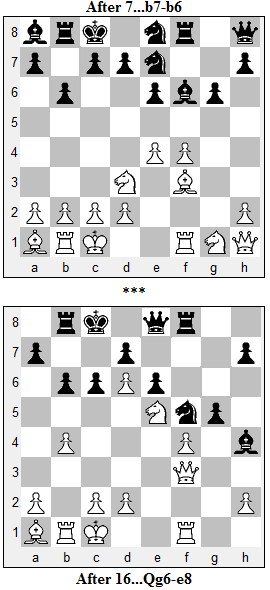In recent months I've lost five important chess960 games. In most of those games I'm not even sure why I lost, so I'm going to spend a few posts looking at them in more depth. Perhaps I can uncover a general pattern of weakness in my play.
There were some extenuating factors in the string of losses:-
- My opponents were competent players, rated 2000+
- I had too many simultaneous games, including traditional chess, most of them against good opponents
- The countdown time control was used in three games
- I had a new tool set, i.e. software and methodology
In all five games I had Black, one of two parallel games with the same opponents where I drew the game where I had White. Achieving +0-1=1 in a single two game mini-match is not a good score; what to say of five such mini-matches?
I've already discussed the countdown time control in two previous posts -- The Lechenicher SchachServer (December 2012) and Thinking Time Can Be a Guide (January 2014) -- where the entire time for a game is allocated at the start of the game. There are no further increments. I now try to play these at the rhythm of one move a day, planning to increase the tempo when the game reaches the endgame. The non-countdown games were also played at a move per day, with a fixed time allocation at the start of the game and one day added per move.
As for the new tool set, the most important consideration is to be comfortable with the methodology. I normally practice a new methodology on unimportant games before trying it important games, but I had no such opportunity before these games were played.
The following game, like the game I discussed in 'Losing Streak', was played in a team match on the SchemingMind server, where I was on first board. SchemingMind is particularly difficult at fast time controls because of the site's no-engine policy.
We were assigned start position SP849 BRKBNRNQ. The most striking characteristic of this SP is the Queen in the corner, facing a Bishop on the long diagonal. After the initial moves 1.Nd3 f5 2.e3 e6 3.f4 g6 4.g4 fxg4 5.Bxg4 Bf6 6.Bf3 Ne7 7.e4 b6, we reached the position shown in the top diagram.
After the further 8.e5 Bxf3 9.Qxf3, I was comfortable with my position and played 9...Bh4, leaving the square g7 for the other pieces. The Bishop is slightly out of play on h4, but is in no particular danger. Now my opponent played 10.b4, a move which I had underestimated. Not only does it develop the Ba1, it also prepares the Rook lift Rb1-b3, where the Rook will operate on both wings. Combined with White's space advantage, this will present ongoing problems for Black. I was no longer feeling so comfortable.

After the further moves 10...Qg7 11.Ne2 c6 12.Nc3 g5 13.Ne4 Qg6 14.Nd6+ Nxd6 15.exd6 Nf5 16.Ne5 Qe8, the game reached the position shown in the bottom diagram. Here White played 17.Rb3. Now I had to decide how to wriggle out of my constricted position.
The move 17...Rb7 proceeds positionally; Black's Rook is temporarily out of play, but by continuing Kb8-a8, the King will be relatively safe in the corner while Black frees his position with Queenside Pawn moves. The move 17...Nxd6 leads to a tactical melee, where White has the upper hand because of the space advantage. I chose 17...Rb7.
My game proceeded as I just outlined, where I eventually sacrificed a Pawn to free the Rook on b7. I hoped to regain the Pawn by capturing on d6, but White was always able to defend it. I eventually tried to set up a fortress, but White was able to breach my defense and I resigned after 70 moves had been played.
If I had to play the position in the second diagram again -- which, given the nature of chess960, I never will -- I would try 17...Nxd6. With active play you might lose quickly, but sitting there for 50 moves struggling to escape a passive position is no fun either.

No comments:
Post a Comment